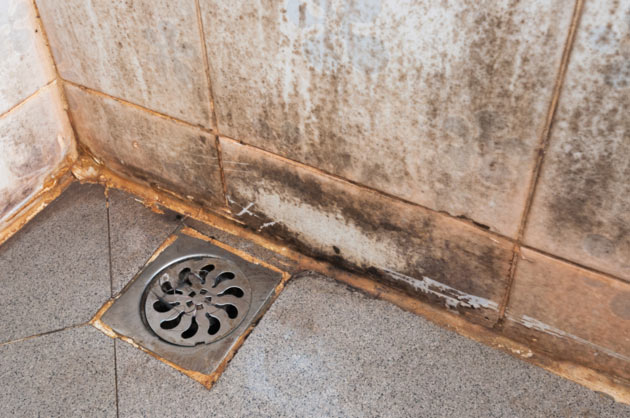Showers and bathtubs are common places for mold growth because of the almost constant dampness that exists. The good news about these areas, however, is that the mold typically grows on porcelain or tile, which are non-porous surfaces, meaning the mold is only on the surface and can easily be cleaned off.
The best way to keep mold out of bathrooms and showers is by providing good air circulation and frequent cleaning.
Step 1- Choose one of the following cleaning solutions
- Mixture of household detergent and water (recommended by the EPA)
- Commercial mold removal product (always follow manufacturer’s instructions on the label)
- Distilled Vinegar
- Baking Soda -Detergent Solution (1/2 cup baking soda, 1 cup water, 1 Tbsp mild liquid detergent)
- Borax Solution (1 gallon of water to 1 cup of borax, or 1 part borax to 16 parts water)
- Bleach-Water Solution (1 gallon of water to 1 cup of bleach, or 1 part bleach to 16 parts water)
Warning: never mix bleach with a product that contains ammonia. It will produce toxic fumes that can cause serious illness or death.
Special note on Bleach: Bleach is an effective option for cleaning mold from showers and other bathroom areas. However, because mold on surfaces like porcelain and tile is easy to remove with just a mild detergent, the EPA does not recommend using bleach. Bleach can be effective, however, if the mold has left a stain on the surface. It is also effective in restoring the white color to caulking around the edges of the shower and tub.
Step 2 – Put on Protective Clothing and Make Safety Precautions
Depending on the severity of the cleaning solution that you chose, you will need to take some safety measures in order to keep yourself free from harm. Because you are working with mold, we recommend the following:
- A respirator, or air mask, that is adequate for blocking mold spores from entering your lungs. The EPA recommends a N95 mask or equivalent.
- Rubber or Nitrile gloves.
- Safety goggles that do not have air vents in the sides.
- If you are moderately sensitive to mold exposure, we recommend wearing coveralls to protect your skin as much as possible. If you are severely sensitive to mold exposure, we recommend getting somebody else to perform the task.
If you are using a product that has strong or dangerous fumes, also make sure your are working in a well ventilated room.
To see more on how to prepare to remove mold, click here.
Step 3 – Apply the Cleaning Solution and Scrub
Apply the cleaning solution that you have elected to use. Start by testing the solution in a small area of the shower to make sure the solution does not cause any discoloring. You can do this with a spray bottle, a lightly damp rag, or a low-abrasive brush or pad. Do not use anything abrasive, such as a wire brush.
Apply the mold removal solution generously.Let the solution sit for a few minutes, then scrub the area in circular motion with your rag, brush, or a scrub pad. Using a disposable towel, or a regular towel that you can disinfect with bleach later, wipe off the area and the excess.
Continue this process until the mold is removed from the surface.
Step 5 – Clean Up and Let Dry
After the mold is removed, clean up the area and either dispose anything that has had contact with the mold, or clean it with a proper detergent or fungicide.
If possible, let the shower dry by keeping it warm and dry with good ventilation. If you live in an area with higher humidity, you may want to place it in a room with a dehumidifier.
Step 6 – Check for Signs of Mold
If mold begins to reappear in the next few weeks, it is probably because your shower doesn’t get enough air circulation. Look for ways to improve air circulation, perhaps by opening a window or running a fan or dehumidifier. If this isn’t possible, the only other prevention method is clean the shower and bathtub surface with a mild cleaner more frequently. This will disrupt the mold growth process and prevent it from getting established.
If the mold reappears, repeat steps 1 through 5.
We hope this was helpful! Please feel free to leave a comment or question below.



How Do I Get Rid Of Mold And Keep It away?
Pingback: next